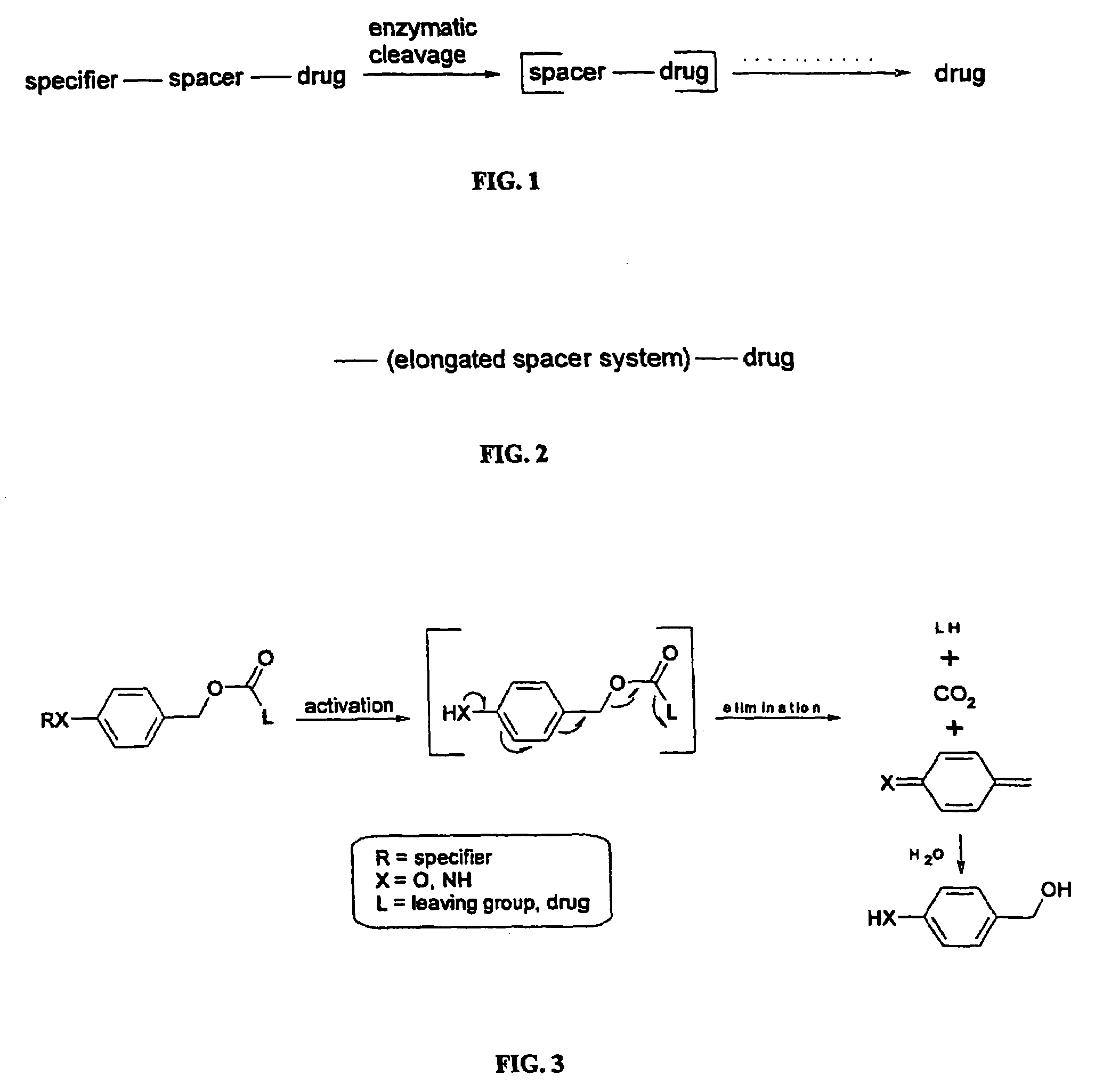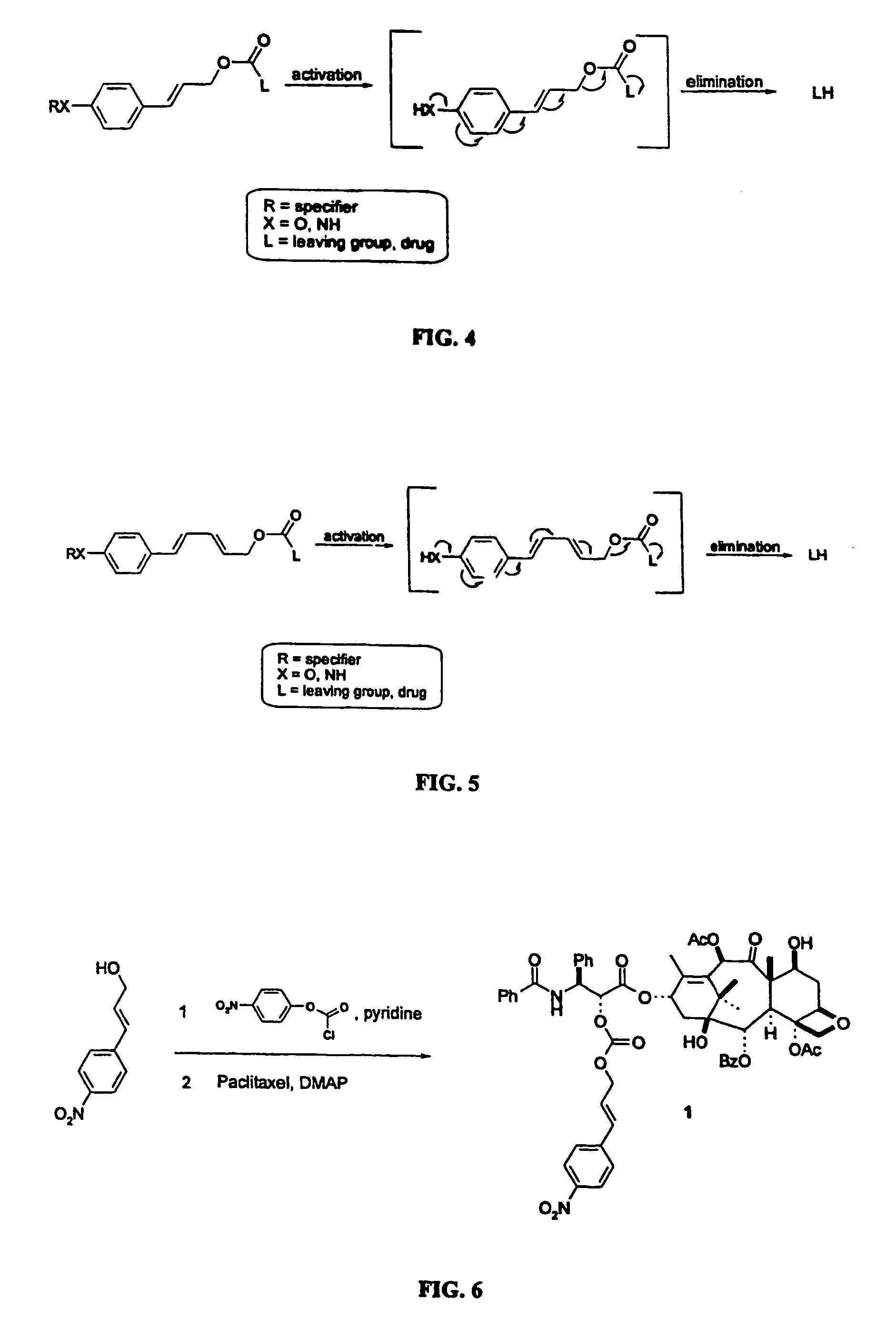Elongated and multiple spacers in activatible prodrugs
a prodrug and activation technology, applied in the field of prodrugs, can solve the problems of drug concentrations that cannot reach the concentration that would completely eradicate the tumor, lack of selectivity of chemotherapeutic agents, and typically associated with severe side effects
- Summary
- Abstract
- Description
- Claims
- Application Information
AI Technical Summary
Benefits of technology
Problems solved by technology
Method used
Image
Examples
example 1
Synthesis of 2′-[4-nitrocinnamyl carbonate]-paclitaxel 1.
[0102]To a solution of 200 mg (1.12 mmol, 4.8 equiv) 4-nitrocinnamyl alcohol in dry dichloromethane / tetrahydrofuran under an Argon atmosphere was added pyridine (94 μl, 5.0 equiv) and 4-nitrophenyl chloroformate (236 mg, 5.0 equiv). The reaction mixture was stirred for 12 h at room temperature. The mixture was cooled to 0° C. and a catalytic amount of DMAP, a few drops of triethyl amine and 200 mg paclitaxel (1.0 equiv) were added. The reaction mixture was stirred at room temperature for 12 h. Solvents were evaporated and the remaining solid was dissolved in dichlorometaane. The organic layer was thoroughly washed with a saturated sodium bicarbonate solution, 0.5 N potassium bisulfate and brine and dried over anhydrous sodium sulfate. After evaporation of the solvents the residual yellow oil was purified by means of column chromatography (ethyl acetate-hexane; 1:1), to yield 144 mg of 1 (58%). M.P. 151° C.; 1H-NMR (300 Mz, CDC...
example 2
Principle of 1,8-elimination: Chemical Reduction of the Nitrocinnamyl Carbonate 1.
[0103]36 mg of 2′-[nitrocinnamyl carbonate]-paclitaxel 1 was dissolved in 8 ml methanol and 2 ml acetic acid. A catalytic amount of zinc powder was added and the red mixture was stirred for 12 h. Dichloromethane was added and the organic layer was washed with saturated sodium bicarbonate, 0.5 N potassium bisulfate, brine, and water and dried over anhydrous sodium sulfate. After evaporation of the solvents the residual yellow film was purified by means of column chromatography (ethyl acetate-hexane; 2:1), to yield 28 mg of paclitaxel (confirmation by 300 MHz 1H-NMR) and 4 mg of unreacted starting compound. When the compound was stirred in the absence of zinc powder under the same conditions, no paclitaxel was formed, indicating that reduction of the nitro group by zinc leads to the release of paclitaxel.
example 3
Synthesis of Aloc-D-Ala-Phe-Lys(Aloc)-OH 9.
Step a: Synthesis of Fmoc-Phe-Lys(Boc)-OBu 4.
[0104]To a solution of 2.50 g Fmoc-Phe-ONSu 2 (ONSu=N-hydroxysuccinimide) (5.16 mmol) in dry dichloromethane under an Argon atmosphere were added at 0° C. 0.791 ml triethyl amine (1.1 eq.) and 1.92 g H-Lys(Boc)OBu.HCl 3 (1.1 eq.). The reaction mixture was stirred at room temperature for 5 hours, then dichloromethane was added and the organic layer was washed with 10% citric acid, saturated sodium bicarbonate and water. The organic layer was dried over anhydrous sodium sulphate and evaporated. The resulting white solid 4 (3.08 g, 89%) was used without further purification. M.P. 93° C.; 1H-NMR (300 MHz, CDCl3): δ 1.10–1.90 (m, 24H, 6 CH2-Lys and 18 tert-butyl), 3.06 (m, 2H, N—CH2-Lys and benzylic), 4.19 (t, 1H, Fmoc), 4.25–4.55 (m, 4H, 2 Fmoc and 2 Hα), 7.19–7.78 (m, 13H, aromatic) ppm; MS (FAB) m / e 672 (M+H)+, 694 (M+Na)+; C39H49N3O7 calculated C, 69.72%; H, 7.35%; N, 6.25%; measured C, 69.69%; H,...
PUM
| Property | Measurement | Unit |
|---|---|---|
| Molar density | aaaaa | aaaaa |
| Molar density | aaaaa | aaaaa |
| Time | aaaaa | aaaaa |
Abstract
Description
Claims
Application Information
 Login to View More
Login to View More - R&D
- Intellectual Property
- Life Sciences
- Materials
- Tech Scout
- Unparalleled Data Quality
- Higher Quality Content
- 60% Fewer Hallucinations
Browse by: Latest US Patents, China's latest patents, Technical Efficacy Thesaurus, Application Domain, Technology Topic, Popular Technical Reports.
© 2025 PatSnap. All rights reserved.Legal|Privacy policy|Modern Slavery Act Transparency Statement|Sitemap|About US| Contact US: help@patsnap.com



